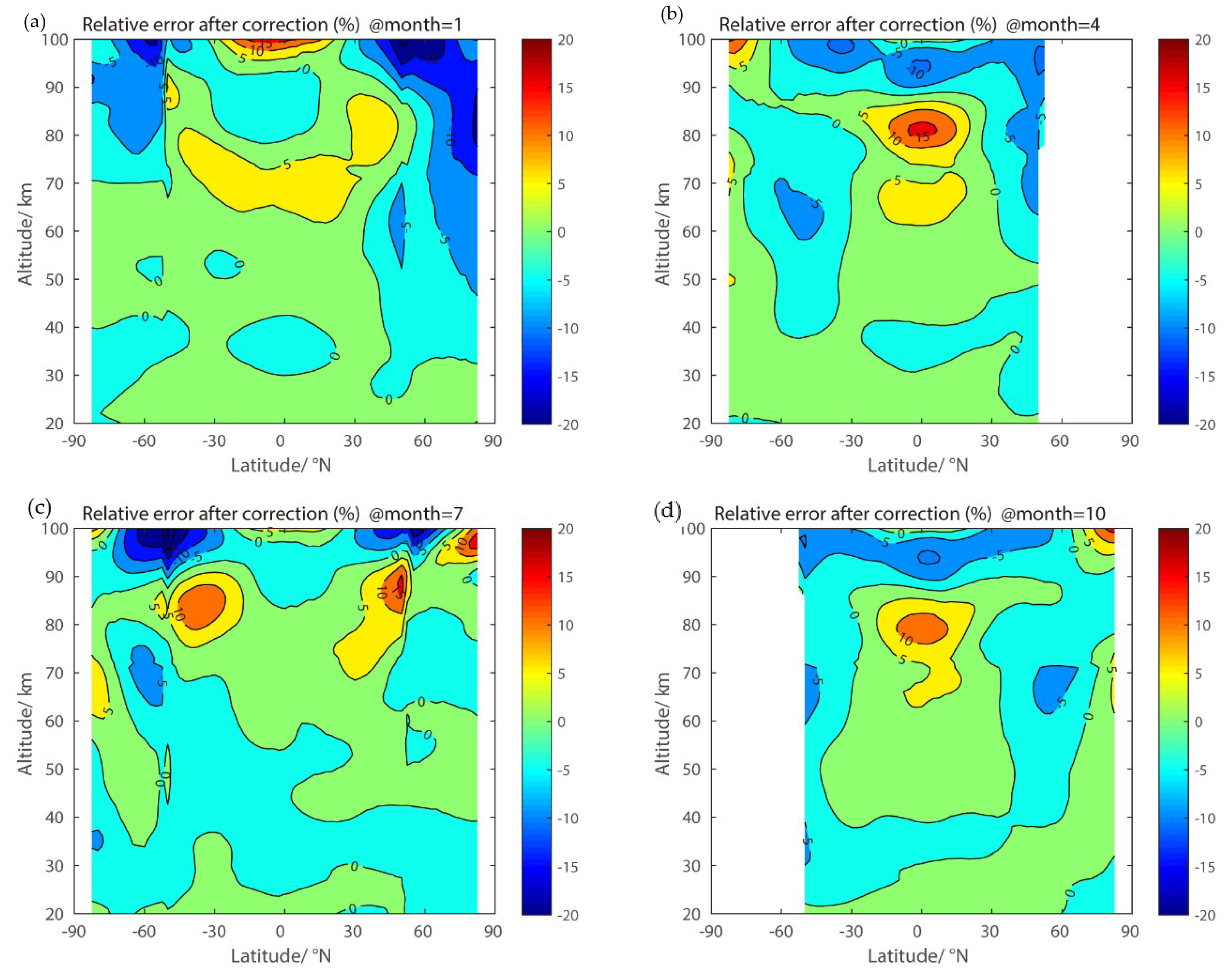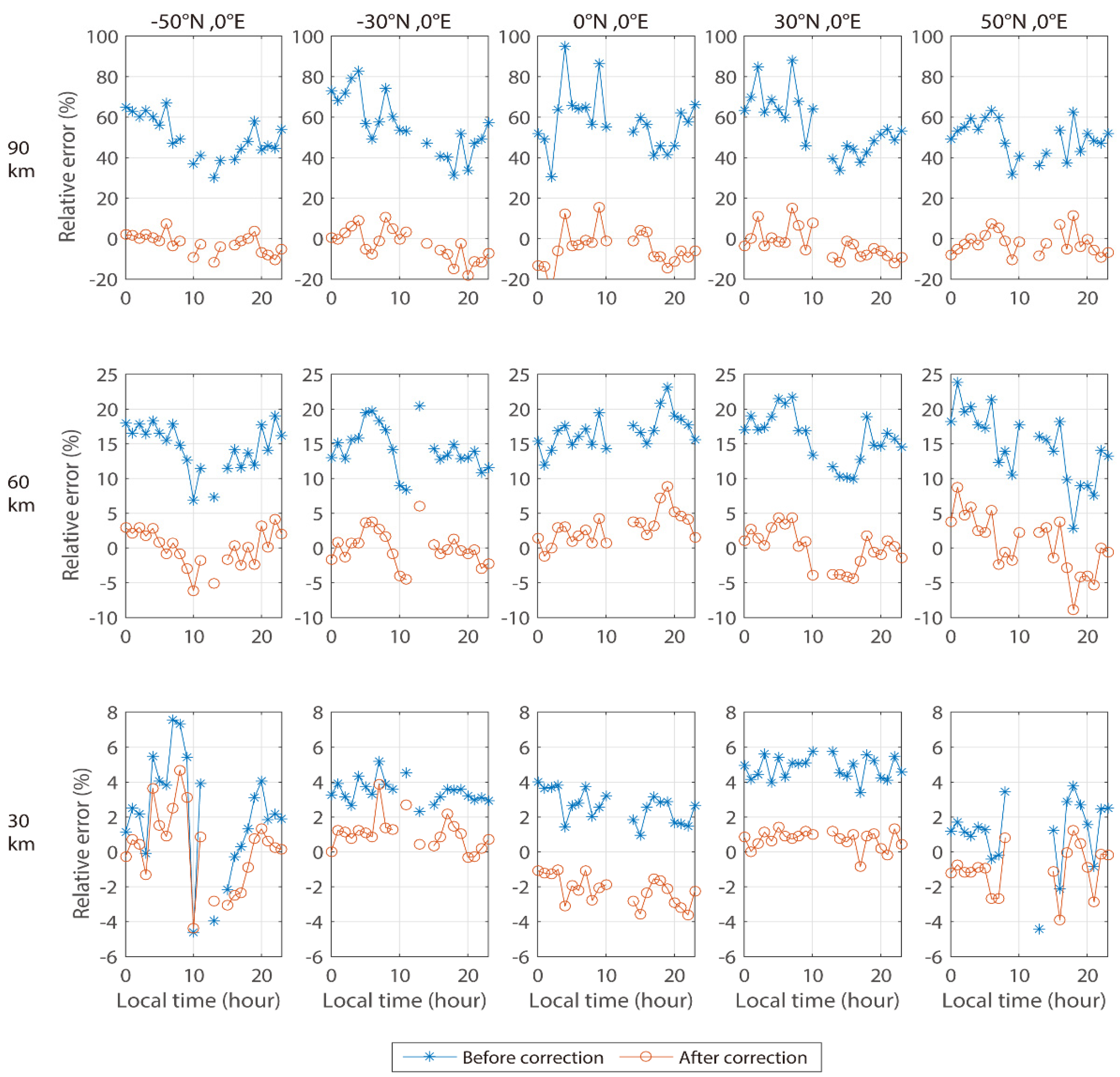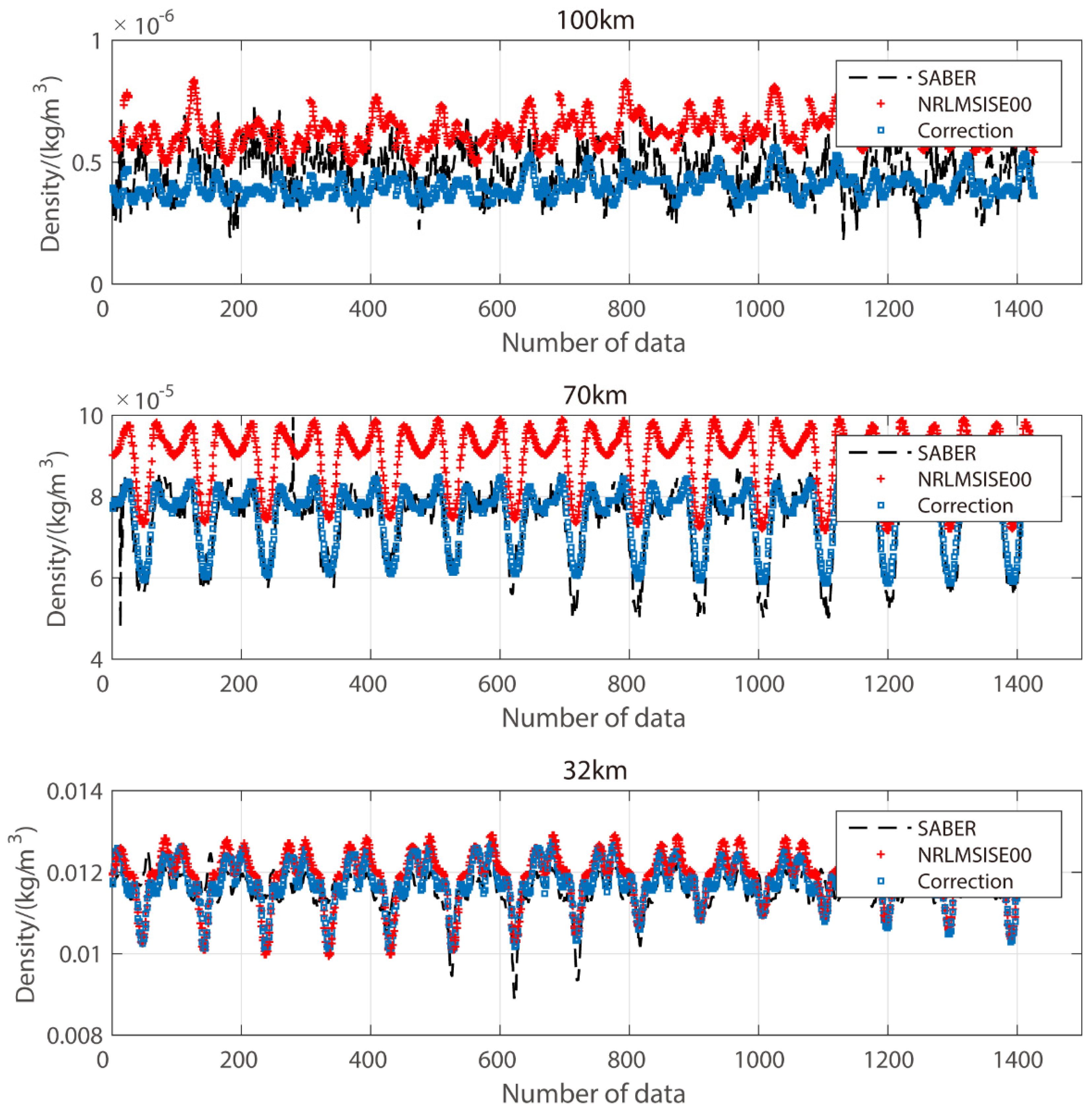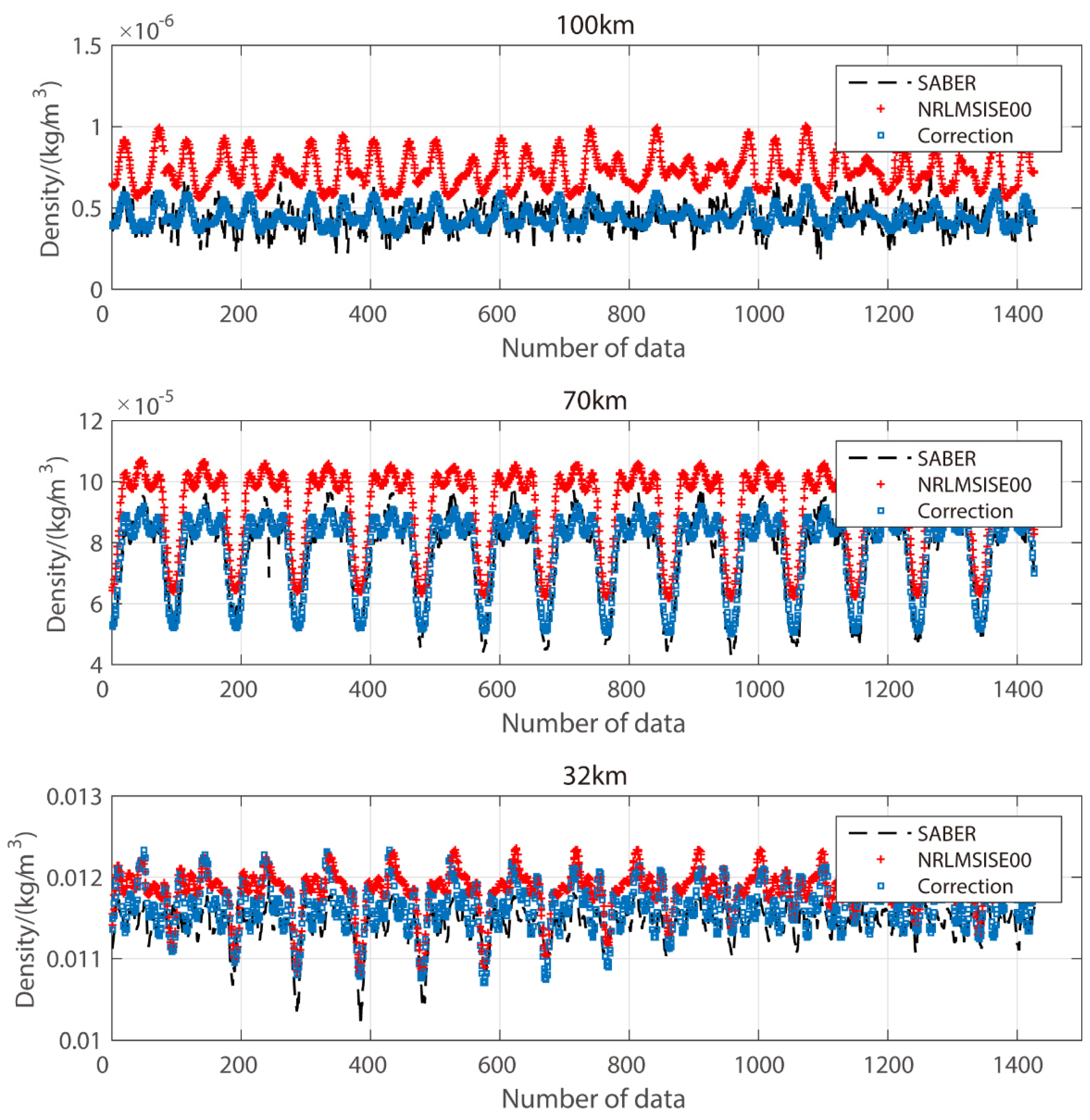Density Correction of NRLMSISE-00 in the Middle Atmosphere (20–100 km) Based on TIMED/SABER Density Data
Abstract
1. Introduction
2. Data Source and Methods
2.1. Database
2.2. Correction Method
2.3. Method of Assessment
3. Results
3.1. Difference between Model and Observations
3.2. Statistical Correction Results
3.2.1. Latitude–Month
3.2.2. Latitude–Altitudes
3.3. Correction Results under Different Local Times
4. Discussion
4.1. Discussion of the Correction Method
4.2. Influence of Geomagnetic Activity
4.3. Influence of Solar Activity
5. Conclusions
Author Contributions
Funding
Acknowledgments
Conflicts of Interest
References
- Huang, R.; Chen, W.; Wei, K.; Wang, L.; Huangfu, J. Atmospheric dynamics in the stratosphere and its interaction with tropospheric processes: Progress and problems. Chin. J. Atmos. Sci. 2018, 42, 463–487. [Google Scholar] [CrossRef]
- Matsuno, T. Vertical Propagation of Stationary Planetary Waves in the Winter Northern Hemisphere. J. Atmos. Sci. 1970, 27, 871–883. [Google Scholar] [CrossRef]
- Alexander, J. A Simulated Spectrum of Convectively Generated Gravity Waves: Propagation from the Tropopause to the Mesopause and Effects on the Middle Atmosphere. J. Geophys. Res. 1996, 101, 1571–1588. [Google Scholar] [CrossRef]
- Semeniuk, K.; Fomichev, V.I.; McConnell, J.C.; Fu, C.; Melo, S.M.L.; Usoskin, I.G. Middle atmosphere response to the solar cycle in irradiance and ionizing particle precipitation. Atmos. Chem. Phys. 2011, 11, 5045–5077. [Google Scholar] [CrossRef]
- Rozanov, E.; Calisto, M.; Egorova, T.; Peter, T.; Schmutz, W. Influence of the Precipitating Energetic Particles on Atmospheric Chemistry and Climate. Surv. Geophys. 2012, 33, 483–501. [Google Scholar] [CrossRef]
- Kim, J.S.; Urbina, J.V.; Kane, T.J.; Spencer, D.B. Improvement of TIE-GCM thermospheric density predictions via incorporation of helium data from NRLMSISE-00. J. Atmos. Sol. Terr. Phys. 2012, 77, 19–25. [Google Scholar] [CrossRef]
- Namgaladze, A.A.; Zubova, Y.V.; Namgaladze, A.N.; Martynenko, O.V.; Doronina, E.N.; Goncharenko, L.P.; Van Eyken, A.; Howells, V.; Thayer, J.P.; Taran, V.I.; et al. Modelling of the ionosphere/thermosphere behaviour during the April 2002 magnetic storms: A comparison of the UAM results with the ISR and NRLMSISE-00 data. Adv. Space Res. 2006, 37, 380–391. [Google Scholar] [CrossRef]
- Park, J.; Moon, Y.J.; Kim, K.H.; Cho, K.S.; Kim, H.D.; Kwak, Y.S.; Kim, Y.H.; Park, Y.D.; Yi, Y. Comparison between the KOMPSAT-1 drag derived density and the MSISE model density during strong solar and/or geomagnetic activities. EarthPlanets Space 2008, 60, 601–606. [Google Scholar] [CrossRef][Green Version]
- Qian, L.Y.; Burns, A.G.; Solomon, S.S.; Smith, A.K.; McInerney, J.M.; Hunt, L.A.; Marsh, D.R.; Liu, H.L.; Mlynczak, M.G.; Vitt, F.M. Temporal Variability of Atomic Hydrogen From the Mesopause to the Upper Thermosphere. J. Geophys. Res. Space 2018, 123, 1006–1017. [Google Scholar] [CrossRef]
- Yurasov, V.S.; Nazarenko, A.I.; Alfriend, K.T.; Cefola, P.J. Reentry time prediction using atmospheric density corrections. J. Guid. Control Dynam. 2008, 31, 282–289. [Google Scholar] [CrossRef]
- Chen, H.R.; Liu, H.X.; Hanada, T. Storm-time atmospheric density modeling using neural networks and its application in orbit propagation. Adv. Space Res. 2014, 53, 558–567. [Google Scholar] [CrossRef]
- Lathuillère, C.; Menvielle, M. Comparison of the observed and modeled low- to mid-latitude thermosphere response to magnetic activity: Effects of solar cycle and disturbance time delay. Adv. Space Res. 2010, 45, 1093–1100. [Google Scholar] [CrossRef]
- Vielberg, K.; Forootan, E.; Luck, C.; Locher, A.; Kusche, J.; Borger, K. Comparison of accelerometer data calibration methods used in thermospheric neutral density estimation. Ann. Geophys. Ger. 2018, 36, 761–779. [Google Scholar] [CrossRef]
- Xu, J.; Qiao, J.; Wei, Y.; Ruiping, M. Comparison between the TIMED observed global temperature distribution and the NRLMSISE-00 empirical atmospheric model. Chin. J. Space Sci. 2006, 26, 177–182. [Google Scholar]
- Zhou, Y.L.; Ma, S.Y.; Lühr, H.; Xiong, C.; Reigber, C. An empirical relation to correct storm-time thermospheric mass density modeled by NRLMSISE-00 with CHAMP satellite air drag data. Adv. Space Res. 2009, 43, 819–828. [Google Scholar] [CrossRef]
- Picone, J.M.; Hedin, A.E.; Drob, D.P.; Aikin, A.C. NRLMSISE-00 empirical model of the atmosphere: Statistical comparison and scientific issues. J. Geophys. Res. 2002, 107, 1468. [Google Scholar] [CrossRef]
- Bergstrom, S.E.; Proulx, R.J.; Cefola, P. Atmospheric density correction using observational data. In Proceedings of the AIAA/AAS Astrodynamics Specialist Conference and Exhibit, Monterey, CA, USA, 5–8 August 2002. [Google Scholar]
- Chen, X.; Hu, X.; Xiao, C.; Wang, X. Correction method of the low earth orbital neutral density prediction based on the satellites data and NRLMSISE-00 model. Chin. J. Geophys. 2013, 56, 3246–3254. [Google Scholar] [CrossRef]
- Shi, C.; Li, W.; Min, L.; Zhao, Q.; Sang, J. Calibrating the scale of the NRLMSISE00 model during solar maximum using the two line elements dataset. Adv. Space Res. 2015, 56, 1–9. [Google Scholar] [CrossRef]
- Mehta, P.M.; Linares, R. A methodology for reduced order modeling and calibration of the upper atmosphere. Space Weather 2017, 15, 1270–1287. [Google Scholar] [CrossRef]
- Zhang, H.; Gu, D.; Duan, X.; Wei, C. Atmospheric density model calibration using emperical orthogonal function. Acta Aeronaut. Astronaut. Sin. 2018, 39, 722263. [Google Scholar] [CrossRef]
- Perez, D.; Bevilacqua, R. Neural Network based calibration of atmospheric density models. Acta Astronaut. 2015, 110, 58–76. [Google Scholar] [CrossRef]
- Xiong, C.; Lühr, H.; Schmidt, M.; Bloßfeld, M.; Rudenko, S. An empirical model of the thermospheric mass density derived from CHAMP satellite. Ann. Geophys. Ger. 2018, 36, 1141–1152. [Google Scholar] [CrossRef]
- Emmert, J.T. Thermospheric mass density: A review. Adv. Space Res. 2015, 56, 773–824. [Google Scholar] [CrossRef]
- Mertens, C.; Russell, J., III; Mlynczak, M.; She, C.-Y.; Schmidlin, F.J.; Goldberg, R.; López-Puertas, M.; Wintersteiner, P.P.; Picard, R.; Winick, J.; et al. Kinetic temperature and carbon dioxide from broadband infrared limb emission measurements taken from the TIMED/SABER instrument. Adv. Space Res. 2009, 43, 15–27. [Google Scholar] [CrossRef]
- Russell, J.M.; Mlynczak, M.G.; Gordley, L.L.; Tansock, J.; Esplin, R. An overview of the SABER experiment and preliminary calibration results. Opt. Spectrosc. Tech. Instrum. Atmos. Space Res. III 1999, 3756, 277–288. [Google Scholar] [CrossRef]
- Remsberg, E.E.; Marshall, B.T.; Garcia-Comas, M.; Krueger, D.; Lingenfelser, G.S.; Martin-Torres, J.; Mlynczak, M.G.; Russell, J.M.; Smith, A.K.; Zhao, Y.; et al. Assessment of the quality of the Version 1.07 temperature-versus-pressure profiles of the middle atmosphere from TIMED/SABER. J. Geophys. Res. 2008, 113, D17101. [Google Scholar] [CrossRef]
- Rezac, L.; Kutepov, A.; Russell Iii, J.; Feofilov, A.; Yue, J.; Goldberg, R. Simultaneous retrieval of T(p) and CO2 VMR from two-channel non-LTE limb radiances and application to daytime SABER/TIMED measurements. J. Atmos. Sol. Terr. Phys. 2015, 130–131, 23–42. [Google Scholar] [CrossRef]
- Gong, X.Y.; Hu, X.; Wu, X.C.; Xiao, C.Y. Comparison of temperature measurement between COSMIC atmospheric radio occultation and SABER/TIMED (in Chinese). Chin. J. Geophys. 2013, 56, 2152–2162. [Google Scholar] [CrossRef]
- Xu, J.; She, C.Y.; Wei, Y.; Mertens, C.; Mlynczak, M.; Russell, J. Comparison between the temperature measurements by TIMED/SABER and lidar in the midlatitude. J. Geophys. Res. Space Phys. 2006, 111, A10S09. [Google Scholar] [CrossRef]
- Xiao, C.Y.; Hu, X.; Wang, B.; Yang, J.F. Quantitative studies on the variations of near space atmospheric fluctuation. Chin. J. Geophys. 2016, 59, 1211–1221. [Google Scholar] [CrossRef]
- Xiao, C.Y.; Hu, X.; Yang, J.F.; Yan, Z.A.; Liu, T.; Cheng, X. Characteristics of atmospheric density at 38° N in near space and its modeling technique. J. Beijing Univ. Aeronaut. Astronaut. 2017, 43, 1757–1765. [Google Scholar] [CrossRef]
- Pancheva, D.; Mukhtarov, P. Atmospheric Tides and Planetary Waves: Recent Progress Based on SABER/TIMED Temperature Measurements (2002–2007). In Aeronomy of the Earth’s Atmosphere and Ionosphere; Springer: Dordrecht, The Netherlands, 2011; pp. 19–56. [Google Scholar] [CrossRef]
- Xu, J.; Smith, A.K.; Yuan, W.; Liu, H.; Wu, Q.; Mlynczak, M.G. The Global Structure and Long Term Variations of the Temperature Observed by TIMED/SABER. J. Geophys. Res. 2006, 112, D24106. [Google Scholar] [CrossRef]
- Zhang, X.; Forbes, J.M.; Hagan, M.E.; Russell, J.M.; Palo, S.E.; Mertens, C.J.; Mlynczak, M.G. Monthly tidal temperatures 20–120 km from TIMED/SABER. J. Geophys. Res. 2006, 111. [Google Scholar] [CrossRef]
- Xuan, C.; Cunying, X.; Xiong, H.; Junfeng, Y. Evaluation of atmospheric empirical model based on TIMED/SABER satellite temperature data. Sci. Sin. Phys. Mech. Astron. 2018, 48, 79–93. [Google Scholar] [CrossRef]
- Day, K.A.; Mitchell, N.J. The 16-day wave in the Arctic and Antarctic mesosphere and lower thermosphere. Atmos. Chem. Phys. 2010, 115. [Google Scholar] [CrossRef]
- Nielsen, K.; Siskind, D.E.; Eckermann, S.D.; Hoppel, K.W.; Coy, L.; McCormack, J.P.; Benze, S.; Randall, C.E.; Hervig, M.E. Seasonal variation of the quasi 5 day planetary wave: Causes and consequences for polar mesospheric cloud variability in 2007. J. Geophys. Res. Atmos. 2010, 115. [Google Scholar] [CrossRef]
- Pancheva, D.; Mukhtarov, P.; Siskind, D.E. The quasi-6-day waves in NOGAPS-ALPHA forecast model and their climatology in MLS/Aura measurements (2005–2014). J. Atmos. Sol. Terr. Phys. 2018, 181, 19–37. [Google Scholar] [CrossRef]
- Lei, J.; Thayer, J.; Forbes, J.M.; Sutton, E.K.; Nerem, R.; Temmer, M.; Veronig, A. Global thermospheric density variations caused by high-speed solar wind streams during the declining phase of solar cycle 23. J. Geophys. Res. 2008, 113, A11303. [Google Scholar] [CrossRef]
- Mengistu Tsidu, G.; Abraha, G. Moderate geomagnetic storms of January 22–25, 2012 and their influences on the wave components in ionosphere and upper stratosphere-mesosphere regions. Adv. Space Res. 2014, 54, 1793–1812. [Google Scholar] [CrossRef]
- Xu, J.; Wang, W.; Zhang, S.-R.; Liu, X.; Yuan, W. Multiday thermospheric density oscillations associated with variations in solar radiation and geomagnetic activity: Thermospheric density oscillations. J. Geophys. Res. Space Phys. 2015, 120, 3829–3846. [Google Scholar] [CrossRef]
- Yi, W.; Reid, I.; Xue, X.; Murphy, D.J.; Hall, C.M.; Tsutsumi, M.; Ning, B.; Li, G.; Younger, J.P.; Chen, T.; et al. High- and Middle-Latitude Neutral Mesospheric Density Response to Geomagnetic Storms. Geophys. Res. Lett. 2018, 45, 436–444. [Google Scholar] [CrossRef]
- Yi, W.; Reid, I.; Xue, X.; Younger, J.P.; Murphy, D.J.; Chen, T.; Dou, X. Response of neutral mesospheric density to geomagnetic forcing. Geophys. Res. Lett. 2017, 44, 8647–8655. [Google Scholar] [CrossRef]
- Staehelin, J.; Harris, N.R.; Appenzeller, C.; Eberhard, J. Ozone trends: A review. Rev. Geophys. 2001, 39, 231–290. [Google Scholar] [CrossRef]
- Hood, L.L. The solar cycle variation of total ozone: Dynamical forcing in the lower stratosphere. J. Geophys. Res. 1997, 102, 1355–1370. [Google Scholar] [CrossRef]
- Luebken, F.-J. No long term change of the thermal structure in the mesosphere at high latitudes during summer. Adv. Space Res. 2001, 28, 947–953. [Google Scholar] [CrossRef]
- Remsberg, E.E.; Deaver, L.E. Interannual, solar cycle, and trend terms in middle atmospheric temperature time series from HALOE. J. Geophys. Res. Atmos 2005, 110, D06106. [Google Scholar] [CrossRef]








| January | April | July | October | ||||
|---|---|---|---|---|---|---|---|
| Mean | Std | Mean | Std | Mean | Std | Mean | Std |
| −0.43 | 0.41 | −0.47 | 0.32 | −0.81 | 0.90 | −0.44 | 0.34 |
| 100 km | 70 km | 32 km | ||||
|---|---|---|---|---|---|---|
| Mean | Std | Mean | Std | Mean | Std | |
| NRLMSISE00 | 41.21 | 32.18 | 22.09 | 7.74 | 3.03 | 4.96 |
| Correction | −9.65 | 22.56 | 2.60 | 5.76 | 1.44 | 4.29 |
| 100 km | 70 km | 32 km | ||||
|---|---|---|---|---|---|---|
| Mean | Std | Mean | Std | Mean | Std | |
| NRLMSISE00 | 68.95 | 33.29 | 21.02 | 8.04 | 3.56 | 1.57 |
| Correction | 3.49 | 20.65 | 2.20 | 6.41 | 1.77 | 1.91 |
© 2020 by the authors. Licensee MDPI, Basel, Switzerland. This article is an open access article distributed under the terms and conditions of the Creative Commons Attribution (CC BY) license (http://creativecommons.org/licenses/by/4.0/).
Share and Cite
Cheng, X.; Yang, J.; Xiao, C.; Hu, X. Density Correction of NRLMSISE-00 in the Middle Atmosphere (20–100 km) Based on TIMED/SABER Density Data. Atmosphere 2020, 11, 341. https://doi.org/10.3390/atmos11040341
Cheng X, Yang J, Xiao C, Hu X. Density Correction of NRLMSISE-00 in the Middle Atmosphere (20–100 km) Based on TIMED/SABER Density Data. Atmosphere. 2020; 11(4):341. https://doi.org/10.3390/atmos11040341
Chicago/Turabian StyleCheng, Xuan, Junfeng Yang, Cunying Xiao, and Xiong Hu. 2020. "Density Correction of NRLMSISE-00 in the Middle Atmosphere (20–100 km) Based on TIMED/SABER Density Data" Atmosphere 11, no. 4: 341. https://doi.org/10.3390/atmos11040341
APA StyleCheng, X., Yang, J., Xiao, C., & Hu, X. (2020). Density Correction of NRLMSISE-00 in the Middle Atmosphere (20–100 km) Based on TIMED/SABER Density Data. Atmosphere, 11(4), 341. https://doi.org/10.3390/atmos11040341




